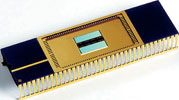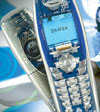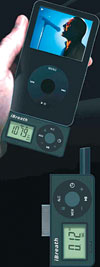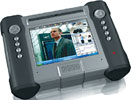
Southern Africa
Saab Grintek has acquired the communications division of Thales Advanced Engineering (TAE) for an undisclosed amount. TAE specialises in providing software and hardware solutions for data networks over military radio systems. The group has developed a proprietary data link protocol required by the SANDF for such applications. The acquired interest in TAE will form part of Saab Grintek's Communications division, which focuses on tactical military radio products and systems. The acquisition is part of Saab Grintek's strategy to expand its business interests in South Africa, said the company.
Goal Technology Solutions (GTS) has been contracted by Zotos Construction to supply one of South Africa's first truly integrated broadband residential solutions. The technology, which uses the existing electricity grid within the estate, will supply the upmarket Park24 development in Kyalami with broadband Internet access and telephone services for all units, as well as surveillance cameras, security communication, and access control. Says GTS CEO Adrian Maguire: "The inherent cost-effectiveness of marrying all functions within residential developments - from essential services such as access control and security to value-added services like Internet access and e-mail to all residents - is very attractive. Broadband across electricity grids is one of the most stable systems available, accessible by simply plugging into any electrical wall socket within the estate." GTS is a systems integrator and a VAR for Mitsubishi Electrical Power Line Communications. Mitsubishi developed its own PLC (power line communications) solution using the 200 Mbps chipsets from Design of Systems on Silicon (DS2).
The Nelson Mandela Metropolitan University (NMMU) in Port Elizabeth is equipping its engineering faculty with the latest technology to train and produce engineers with the necessary skills to address South Africa's shortage in robotic and mechatronic skills. NMMU will become the first university in the Eastern Cape to offer a Bachelor of Engineering Mechatronics degree. Students will use CATIA, which is part of a complete range of product lifecycle management (PLM) solutions from IBM and Dassault Systémes, as the CAD/CAM software solution. NMMU recently acquired a robotics laboratory through a consortium agreement with local industry and government.
Overseas
Business
Uniross, a European leader in rechargeable batteries and chargers, was listed on the Paris Euronext stock exchange on 26 July 2006. Uniross said that its listing will allow it to reinforce its equity and to accelerate its worldwide development, notably in the US. Uniross makes 75% of its turnover worldwide through its subsidiaries (England, Italy, Germany, China, USA, South Africa, Hong-Kong) and through its network of agents, based in more than 70 countries.
Companies
Analog Devices has acquired AudioAsics, a Danish mixed-signal specialist for approximately $19m. AudioAsics develops high-performance, low-power microphone and audio signal-conditioning technology.
iWatt, a supplier of power conversion IC technology, has acquired Simple Silicon, a designer of analog front-end devices for products such as LCD TVs, digital cameras and DVD players. It also supplies analog building blocks such as power management, ADCs, DACs, PLLs.
Manufacturing services provider Elcoteq, headquartered in Espoo, Finland, has agreed to acquire Andrew's manufacturing facility in Arad, Romania, for $19m.
French firm Uniross has acquired the rechargeable battery specialist, the North American Battery Company (NABC). The acquisition will enable Uniross to strengthen its distribution network in the US, Canada, Mexico and South America. Rechargeable batteries for the consumer market account for nearly 80% of NABC's revenue, as is the case for Uniross.
3M has announced it has acquired Credence Technologies, a provider of instruments and high-end monitoring equipment for electrostatic discharge control and electromagnetic compliance.
Motorola has agreed to purchase Symbol Technologies, an RFID and Wi-Fi product supplier (bar code scanners, handheld computers, wireless networking equipment), for $3,9 bn in stock. Symbol will become a unit of Motorola's networks and enterprise business.
Ericsson is reorganising its structure and will shift its focus to providing infrastrucure for integrated multimedia. The company said the new organisation goes into effect on 1 Jan, 2007. It will consist of three business units: Multimedia, Networks and Global Services.
Intel has announced that it has completed the sale of product lines and associated assets of its optical-networking components business to Cortina Systems.
Freescale Semiconductor and German company Elmos Semiconductor, will team to develop application-specific semiconductor products (ASSPs) combining Freescale's 16-bit microcontroller architectures with Elmos' high-voltage CMOS ASSPs. The companies are focusing development on body control solutions, remote motor control units for comfort functions, and safety applications.
Siemens Communications and Intel will cooperate in the development of open unified communications based on Voice over Internet Protocol (VoIP). The cooperation will centre on wireless security and realtime communications as well as specific collaboration applications. The companies will jointly fund and cooperatively conduct research focused on secure wireless networks and realtime open unified communications in the short term as well as work together longer term to create comprehensive vertical industry collaboration solutions.
Japan's Fujitsu and Advantest plan to establish a joint venture to create prototype semiconductors by using electron-beam direct lithography.
Faraday Technology, an ASIC and intellectual property vendor, and MorethanIP, an Ethernet IP provider, have entered into a partnership to engage on 10-gigabit Ethernet XAUI and IEEE 1588 networking ASIC and structured-ASIC applications. The 10GbE market has picked up momentum during the past year, and with IEEE 1588, say the companies, it is now possible to synchronise, in the sub-microsecond range, the local clocks in sensors, actuators, and other terminal devices using a common Ethernet network.
Mosaid Technologies has signed a patent licensing agreement with the California Institute of Technology covering certain Caltech patents relating to technologies used in wireless communications chips and systems, power management chips and LEDs.
Arisawa, Seiko Epson, Texas Instruments, and JVC have teamed to establish the Micro Device Display Consortium (MDDPC), to promote the features and advantages of microdevice display projection TVs (MDDP). The consortium aims to promote the growth of MDDPs and boost public awareness of the technology. In addition to the founding members, 3M, Luminus Devices, Samsung Japan, and SCRAM Technologies have joined the consortium as endorsing members.
Millennium Cell has teamed with Gecko Energy Technologies to develop a fuel-cell powered wireless camera prototype system with infrared sensing and audio capability. The hydrogen battery integrates Millennium's Hydrogen-on-Demand sodium borohydride fuel technology and Gecko's PowerSkin fuel cell technology.
Two US agencies, the National Security Agency (NSA) and the National Institute of Standards and Technology (NIST), have announced they will work with University of Maryland scientists to explore atomic physics, condensed matter and quantum information. They will set up the Joint Quantum Institute (JQI) on the university's campus.
Industry
Mobile phone display shipments reached 275,3 million main displays and 60,7 million sub-displays in the second quarter of 2006, flat with the previous quarter, though up 32% year over year, according to a report by DisplaySearch. Mobile phone display revenue was $2,9 bn, down 5% quarter-to-quarter and 4% year-to-year, reflecting a 27% year-to-year drop in average selling prices. Overall, Samsung led in mobile phone display shipments with 44,9 million, or 16,3% of the market, followed by Philips, Sanyo Epson, Sharp, and Wintek.
Toshiba was the top supplier of hard drives for portable devices in the second quarter of 2006, according to IDC. Toshiba's global market share in 2,5" and smaller hard drives is 27% - the fourth consecutive quarter the company has led in mobile hard drive shipments, reported IDC.
Worldwide PC revenues could dip this year as manufacturers drop prices to attract buyers, according to Gartner. The research firm said that revenues are expected to fall by 2,5% this year to $198,3 bn, while shipments, on the other hand, are expected to increase by 10,5% to 233,7 million units.
The Trusted Computing Group (TCG) has officially rolled out its standard for cellphone security. The draft mobile trusted module (MTM) spec is available free of charge at www.trustedcomputinggroup.org. It says that this open specification will enable the development of stronger security, enhanced privacy and reduced risk of loss and theft for mobile phone users and providers of handsets and services.
Intel has created one of the most remote WiMAX wireless networks in the town of Parintins on an island in the Amazon river in Brazil. The network is expected to improve the healthcare and education of the town's 114 000 residents and is part of Intel's plans to invest more than $1bn over the next five years to accelerate computer and Internet access for those in developing communities.
On the heels of the EU's Restriction of Hazardous Substances (RoHS) directive, which took effect 1 July, US components distributor Newark InOne is calling for a comparable law to be enacted in the United States. Although no national RoHS-style legislation has yet been proposed, California has enacted its own RoHS rule, SB20/SB50, which takes effect on 1 January. The state's rule is not as comprehensive as the EU's RoHS. Says Paul Tallentire, president of Newark InOne: "Are we going to wait until we have 50 state laws with 50 flavours, before we enact a uniform national standard for our industry?'
Toshiba has launched a program to exchange faulty Sony battery packs used in 340 000 of its laptops.
Lantronix has announced its second annual Wireless Design Contest that challenges engineers to wirelessly network-enable a machine or device using Lantronix WiPort - an embedded 802.11 b/g wireless Device Server. To qualify for nearly $20 000 in prizes, contestants must register their product at www.lantronix.com and submit a working prototype board design complete with a documented summary of the project and its operation. All entries must be received by 1 March, 2007. Additional awards will be given for the best entry from a student or educational institute, one using the lowest power usage and one using 802.11 b/g and Ethernet-swappable combination.
Sony has announced that it would introduce a Blu-ray Disc (BD) recorder in Japan by the year's end.
The UK Government has launched a £1bn scheme to help people gain the job skills they require to boost English productivity and competitiveness and improve opportunities for low-skilled employees. Called 'Train to Gain' the service, run by the Learning and Skills Council, is expected to help 50 000 employers and 350 000 employees every year.
Technology
Researchers from the University of California, Santa Barbara (UCSB) and Intel have built the world's first electrically-powered hybrid silicon laser using standard silicon manufacturing processes. The researchers were able to combine the light-emitting properties of indium phosphide with the light-routing capabilities of silicon into a single hybrid chip. When voltage is applied, light generated in the indium phosphide enters the silicon waveguide to create a continuous laser beam that can be used to drive other silicon photonic devices. According to the scientists, a laser based on silicon could drive wider use of photonics in computers because the cost can be greatly reduced by using high-volume silicon manufacturing techniques. While still far from becoming a commercial product, they suggest being able to place hundreds or thousands of data-carrying light beams on standard industry chips 'could bring low-cost, terabit-level optical data pipes inside future computers, and help make possible a new era of high-performance computing applications'

Samsung Electronics has announced it has completed the industry's first fully working prototype of a 512 Mbit phase-change random access memory (PRAM). The company believes this will become the main memory device to replace high-density NOR flash memories within the next decade. A key advantage in PRAM is its extremely fast performance - it can rewrite data without having to first erase data previously accumulated. It is effectively 30-times faster than conventional flash memory, says Samsung, as well as it is expected to have at least 10 times the life of flash.

Cambridge Silicon Radio has launched a VoIP phone based on the company's UniFi single-chip WiFi technology. Named UniVox, CSR claims it will enable manufacturers to produce wireless phones for residential use 'at the lowest cost, and lowest power with up to 20 hours talk time and 400 hours standby time from typical handset batteries, using latest generation access points'. CSR is providing customers with schematics, layout and bill of materials (BOM) as well as royalty-free design software. The total cost of components listed in the BOM is under $20, according to CSR.

Simply RISC, a team of former STMicroelectronics engineers who have been working in Catania, Italy and Bristol, UK, has released its first design: the S1 Core (codenamed Sirocco) - a cut-down version of Sun's OpenSPARC T1 processor that targets embedded devices such as PDAs, set-top boxes and digital cameras. It is offering the S1 core for free. Simply RISC develops and supports CPU cores, peripherals and interfaces released under the GNU General Public License (GPL) to build up free hardware design of microprocessors, systems-on-a-chip and networks-on-a-chip. The development environment of the S1 Core can run on any Unix/Linux box and no commercial tools are required.
David Steele Enterprises has brought out the iBreath - an iPod accessory that is a fully-functioning alcohol breathalyser and which also incorporates an iPod FM transmitter to transmit the iPod's tunes to any nearby FM tuner. To use, the wand on the gadget is folded out and blown into for 5 seconds. The blood alcohol content (BAC) is then shown 5 seconds later.

The 'Catcher' is a military-grade UMPC (ultra-mobile PC) that boasts a 1,7 GHz Pentium M processor, 2 GB of RAM, 40 GB hard drive, 802.11a/b/g support, Bluetooth, dual-mode CDMA/GSM data, fingerprint reader, GPS, iris scan, a pair of VGA cameras (one pointing toward the user, and one away), is weatherproof, can withstand a metre fall onto cement and over 50g of shock. The Catcher (communications and telemetry computing handheld for emergency response) ruggedised UMPC will be used by the US military. It also has an 'emergency alert feature' that sends an auto-tracking signal back to the server. When pressed, a message is sent and both cameras and internal microphone begin recording and relaying data to a command base. The screen measures 16,3 cm and it runs Windows XP Tablet edition.

© Technews Publishing (Pty) Ltd | All Rights Reserved